Walbank F.W., Astin A.E., Frederiksen M.W., Ogilvie R.M. The Cambridge Ancient History, Volume 7, Part 1: The Hellenistic World
Подождите немного. Документ загружается.

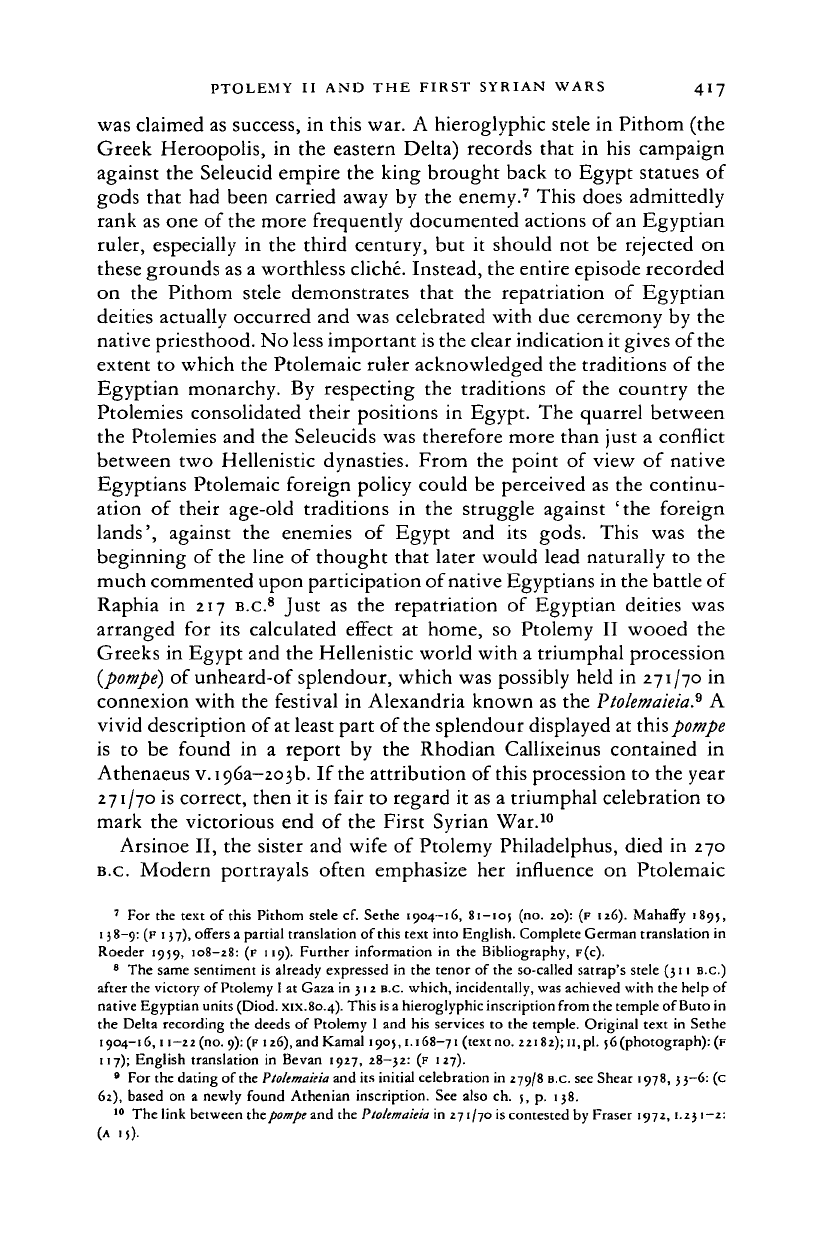
PTOLEMY II AND THE FIRST SYRIAN WARS 417
was claimed as success,
in
this war.
A
hieroglyphic stele
in
Pithom (the
Greek Heroopolis,
in the
eastern Delta) records that
in his
campaign
against
the
Seleucid empire the king brought back
to
Egypt statues
of
gods that
had
been carried away
by the
enemy.
7
This does admittedly
rank as one
of
the more frequently documented actions
of
an Egyptian
ruler, especially
in the
third century,
but it
should
not be
rejected
on
these grounds as a worthless cliche. Instead, the entire episode recorded
on
the
Pithom stele demonstrates that
the
repatriation
of
Egyptian
deities actually occurred and was celebrated with due ceremony
by the
native priesthood. No less important is the clear indication it gives of the
extent
to
which the Ptolemaic ruler acknowledged the traditions
of
the
Egyptian monarchy.
By
respecting
the
traditions
of the
country
the
Ptolemies consolidated their positions
in
Egypt. The quarrel between
the Ptolemies and the Seleucids was therefore more than just
a
conflict
between
two
Hellenistic dynasties. From
the
point
of
view
of
native
Egyptians Ptolemaic foreign policy could
be
perceived as
the
continu-
ation
of
their age-old traditions
in the
struggle against
'the
foreign
lands',
against
the
enemies
of
Egypt
and its
gods. This
was the
beginning
of
the line
of
thought that later would lead naturally
to the
much commented upon participation of native Egyptians in the battle of
Raphia
in 217
B.C.
8
Just
as the
repatriation
of
Egyptian deities
was
arranged
for its
calculated effect
at
home,
so
Ptolemy
II
wooed
the
Greeks
in
Egypt and the Hellenistic world with a triumphal procession
{pompe)
of
unheard-of splendour, which was possibly held
in
271/70
in
connexion with the festival
in
Alexandria known as the
Pto/emaieia.
9
A
vivid description of
at
least part of the splendour displayed at this pompe
is
to be
found
in a
report
by the
Rhodian Callixeinus contained
in
Athenaeus
v.
196a—203b.
If
the attribution
of
this procession
to
the year
271/70 is correct, then
it
is fair
to
regard
it
as a triumphal celebration
to
mark
the
victorious
end of
the First Syrian War.
10
Arsinoe
II, the
sister and wife
of
Ptolemy Philadelphus, died
in 270
B.C.
Modern portrayals often emphasize
her
influence
on
Ptolemaic
7
For the
text
of
this Pithom stele
cf.
Sethe 1904-16, 81-105
(no.
20): (F 126). Mahaffy 1895,
138-9:
(F
1
37),
offers a partial translation of this text into English. Complete German translation
in
Roeder 1959, 108-28: (F 119). Further information
in the
Bibliography,
F(C).
8
The same sentiment
is
already expressed
in the
tenor
of
the so-called satrap's stele (311
B.C.)
after the victory
of
Ptolemy I
at
Gaza in
31 2
B.C. which, incidentally, was achieved with the help of
native Egyptian units (Diod. xix.80.4). This
is a
hieroglyphic inscription from the temple of Buto in
the Delta recording the deeds
of
Ptolemy
I and his
services
to
the temple. Original text
in
Sethe
1904-16,11-22 (no.
9):
(F
126),
and Kamal 1905,1.168-71 (text
no.
22182);
11,
pi.
56(photograph):
(F
117);
English translation
in
Be van 1927, 28—32: (F
127).
* For the dating of
the Ptolimaieia
and its initial celebration in 279/8
B.C.
see Shear 1978, 33-6:
(c
62),
based
on a
newly found Athenian inscription.
See
also ch.
j,
p. 138.
10
The link between the
pompe
and the
PtoUmaieia
in 271/70 is contested by Fraser 1972,1.23 1—2:
(A
!
().
Cambridge Histories Online © Cambridge University Press, 2008
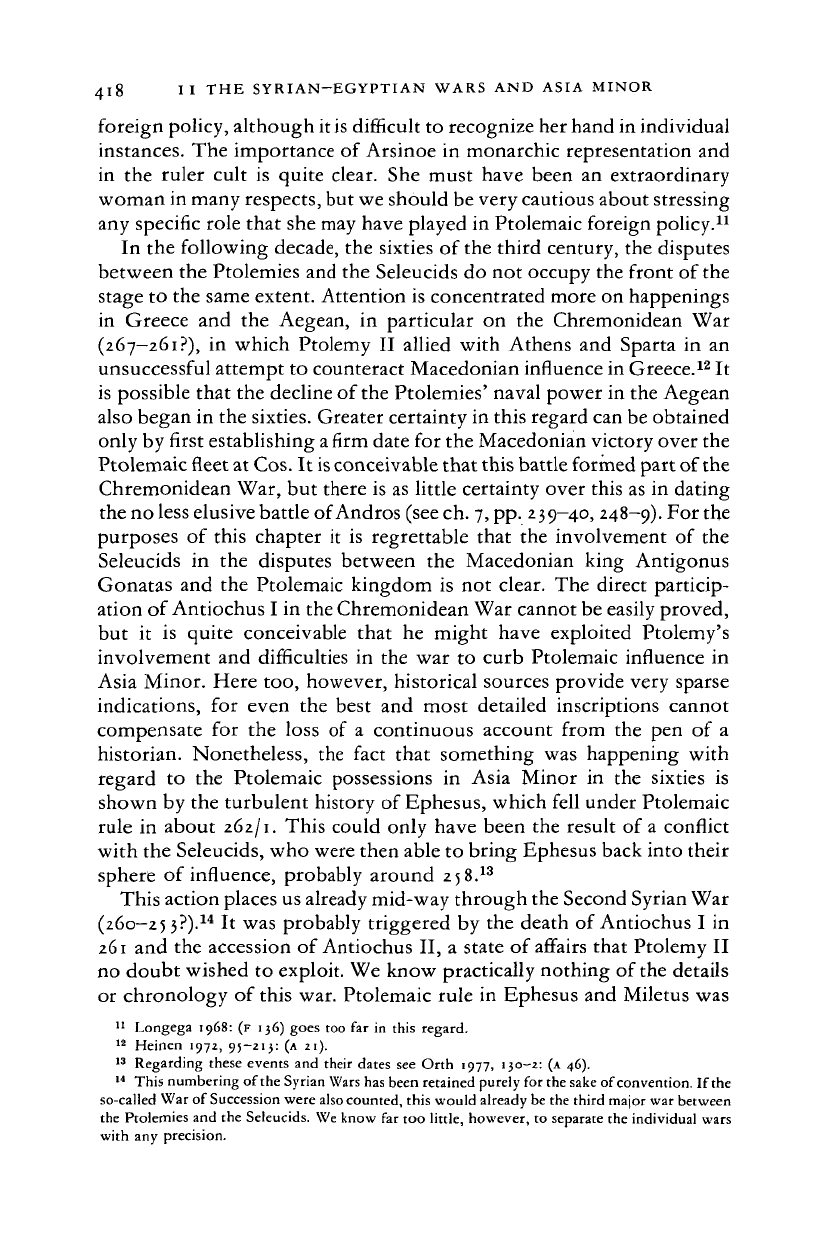
418 II THE SYRIAN-EGYPTIAN WARS AND ASIA MINOR
foreign policy, although it
is
difficult to recognize her hand in individual
instances. The importance
of
Arsinoe
in
monarchic representation and
in
the
ruler cult
is
quite clear. She must have been
an
extraordinary
woman in many respects, but we should be very cautious about stressing
any specific role that she may have played in Ptolemaic foreign policy.
11
In the following decade, the sixties of the third century, the disputes
between the Ptolemies and the Seleucids do not occupy the front of the
stage to the same extent. Attention is concentrated more on happenings
in Greece
and the
Aegean,
in
particular
on the
Chremonidean
War
(267—261?),
in
which Ptolemy
II
allied with Athens
and
Sparta
in an
unsuccessful attempt to counteract Macedonian influence in Greece.
12
It
is possible that the decline of the Ptolemies' naval power in the Aegean
also began in the sixties. Greater certainty in this regard can be obtained
only by first establishing a
firm
date for the Macedonian victory over the
Ptolemaic fleet at
Cos.
It
is
conceivable that this battle formed part of the
Chremonidean War, but there is as little certainty over this as
in
dating
the no less elusive battle of Andros (see
ch.
7, pp. 239-40, 248-9). For the
purposes
of
this chapter
it is
regrettable that
the
involvement
of
the
Seleucids
in the
disputes between
the
Macedonian king Antigonus
Gonatas and
the
Ptolemaic kingdom
is not
clear. The direct particip-
ation of Antiochus
I
in the Chremonidean War cannot be easily proved,
but
it is
quite conceivable that
he
might have exploited Ptolemy's
involvement and difficulties
in the
war
to
curb Ptolemaic influence
in
Asia Minor. Here too, however, historical sources provide very sparse
indications,
for
even
the
best
and
most detailed inscriptions cannot
compensate
for the
loss
of a
continuous account from
the pen of a
historian. Nonetheless,
the
fact that something
was
happening with
regard
to the
Ptolemaic possessions
in
Asia Minor
in the
sixties
is
shown by the turbulent history of Ephesus, which fell under Ptolemaic
rule
in
about
262/1.
This could only have been the result
of
a conflict
with the Seleucids, who were then able to bring Ephesus back into their
sphere
of
influence, probably around
258.
13
This action places us already mid-way through the Second Syrian War
(260—25
3?).
14
It
was probably triggered
by
the death
of
Antiochus
I in
261 and the accession
of
Antiochus II,
a
state
of
affairs that Ptolemy
II
no doubt wished to exploit. We know practically nothing of the details
or chronology
of
this war. Ptolemaic rule
in
Ephesus and Miletus was
11
Longega 1968: (F 136) goes too
far in
this regard.
12
Heinen 1972, 95-213: (A
21).
13
Regarding these events
and
their dates
see
Orth 1977, 130-2:
(A
46).
14
This numbering of the Syrian Wars has been retained purely for the sake of convention. If the
so-called War
of
Succession were also counted, this would already be the third major war between
the Ptolemies and the Seleucids. We know
far
too little, however, to separate the individual wars
with
any
precision.
Cambridge Histories Online © Cambridge University Press, 2008
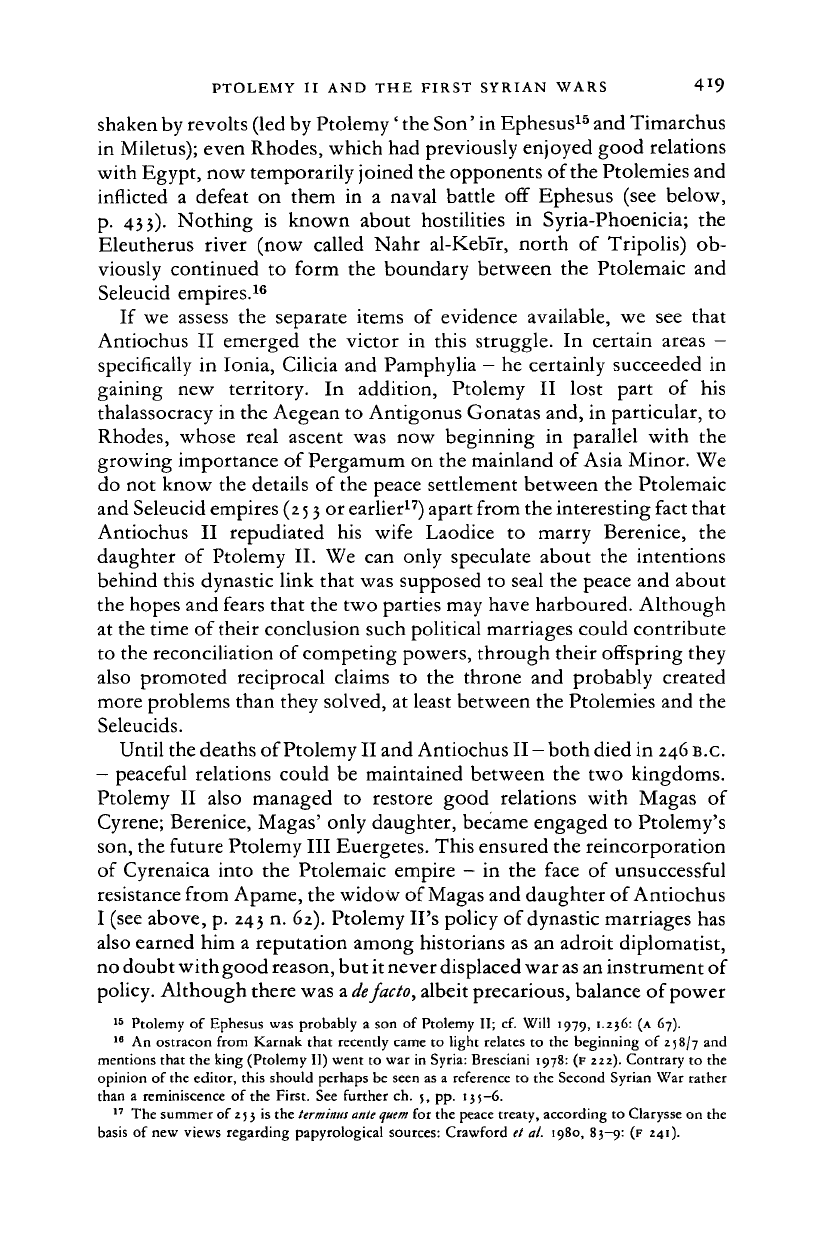
PTOLEMY II AND THE FIRST SYRIAN WARS 4
J
9
shaken by revolts (led by Ptolemy' the Son' in Ephesus
15
and Timarchus
in Miletus); even Rhodes, which had previously enjoyed good relations
with Egypt, now temporarily joined the opponents of the Ptolemies and
inflicted
a
defeat
on
them
in a
naval battle
off
Ephesus
(see
below,
p.
433). Nothing
is
known about hostilities
in
Syria-Phoenicia;
the
Eleutherus river
(now
called Nahr al-KebTr, north
of
Tripolis)
ob-
viously continued
to
form
the
boundary between
the
Ptolemaic
and
Seleucid empires.
16
If we assess
the
separate items
of
evidence available,
we see
that
Antiochus
II
emerged
the
victor
in
this struggle.
In
certain areas
—
specifically
in
Ionia, Cilicia and Pamphylia
—
he certainly succeeded
in
gaining
new
territory.
In
addition, Ptolemy
II
lost part
of his
thalassocracy in the Aegean to Antigonus Gonatas and, in particular,
to
Rhodes, whose real ascent
was now
beginning
in
parallel with
the
growing importance
of
Pergamum on the mainland
of
Asia Minor. We
do
not
know the details
of
the peace settlement between the Ptolemaic
and Seleucid empires
(25 3
or earlier
17
) apart from the interesting fact that
Antiochus
II
repudiated
his
wife Laodice
to
marry Berenice,
the
daughter
of
Ptolemy
II. We can
only speculate about
the
intentions
behind this dynastic link that was supposed
to
seal the peace and about
the hopes and fears that the two parties may have harboured. Although
at the time
of
their conclusion such political marriages could contribute
to the reconciliation of competing powers, through their offspring they
also promoted reciprocal claims
to the
throne
and
probably created
more problems than they solved,
at
least between the Ptolemies and the
Seleucids.
Until the deaths of Ptolemy II and Antiochus II
-
both died in
246
B.C.
—
peaceful relations could
be
maintained between
the two
kingdoms.
Ptolemy
II
also managed
to
restore good relations with Magas
of
Cyrene; Berenice, Magas' only daughter, became engaged
to
Ptolemy's
son, the future Ptolemy III Euergetes. This ensured the reincorporation
of Cyrenaica into
the
Ptolemaic empire
—
in the
face
of
unsuccessful
resistance from Apame, the widow of
Magas
and daughter of Antiochus
I (see above, p. 243 n. 62). Ptolemy II's policy of dynastic marriages has
also earned him
a
reputation among historians as an adroit diplomatist,
no doubt with good reason, but it never displaced war
as
an instrument of
policy. Although there was
a
de
facto,
albeit precarious, balance of power
15
Ptolemy
of
Ephesus was probably
a
son
of
Ptolemy
II; cf.
Will 1979,
1.236:
(A
67).
18
An
ostracon from Karnak that recently came
to
light relates
to the
beginning
of
258/7
and
mentions that the king (Ptolemy II) went
to
war
in
Syria: Bresciani 1978: (F 222). Contrary
to the
opinion
of
the editor, this should perhaps
be
seen as a reference
to
the Second Syrian War rather
than
a
reminiscence
of
the First. See further ch.
5,
pp. 135-6.
17
The summer
of
25 3
is the
terminus ante quern
for the peace treaty, according
to
Clarysse on the
basis
of
new views regarding papyrological sources: Crawford et al. 1980, 83-9: (F 241).
Cambridge Histories Online © Cambridge University Press, 2008
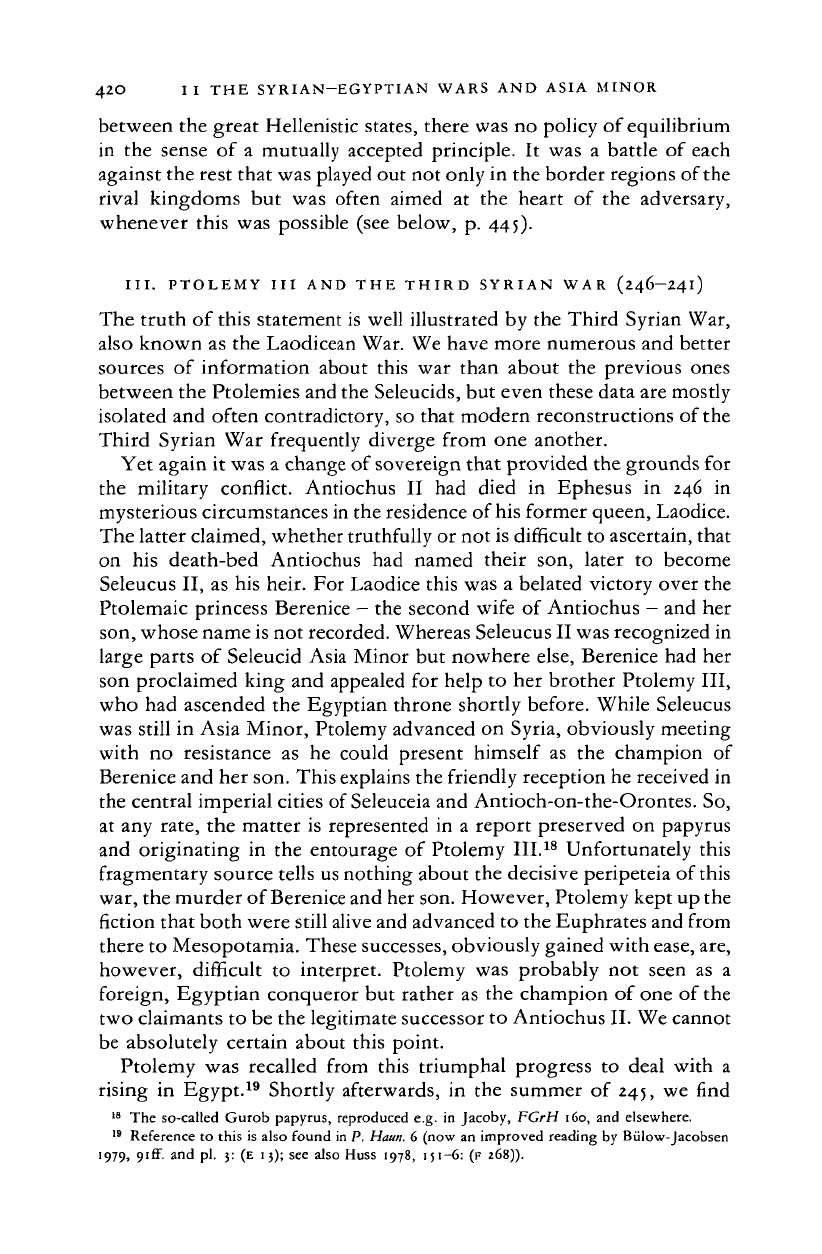
42O II THE SYRIAN-EGYPTIAN WARS AND ASIA MINOR
between the great Hellenistic states, there was no policy of equilibrium
in
the
sense
of a
mutually accepted principle.
It
was
a
battle
of
each
against the rest that was played out not only in the border regions of the
rival kingdoms
but was
often aimed
at the
heart
of the
adversary,
whenever this was possible (see below,
p.
445).
III.
PTOLEMY
III AND THE
THIRD SYRIAN
WAR
(246—241)
The truth
of
this statement is well illustrated by the Third Syrian War,
also known as the Laodicean War. We have more numerous and better
sources
of
information about this
war
than about
the
previous ones
between the Ptolemies and the Seleucids, but even these data are mostly
isolated and often contradictory, so that modern reconstructions of the
Third Syrian War frequently diverge from one another.
Yet again
it
was
a
change of sovereign that provided the grounds for
the military conflict. Antiochus
II had
died
in
Ephesus
in 246 in
mysterious circumstances in the residence of
his
former queen, Laodice.
The latter claimed, whether truthfully or not is difficult to ascertain, that
on
his
death-bed Antiochus
had
named their
son,
later
to
become
Seleucus II,
as
his heir. For Laodice this was
a
belated victory over the
Ptolemaic princess Berenice
—
the second wife
of
Antiochus
—
and her
son, whose name is not recorded. Whereas Seleucus II was recognized in
large parts
of
Seleucid Asia Minor but nowhere else, Berenice had
her
son proclaimed king and appealed
for
help
to
her brother Ptolemy III,
who had ascended the Egyptian throne shortly before. While Seleucus
was still
in
Asia Minor, Ptolemy advanced
on
Syria, obviously meeting
with
no
resistance
as he
could present himself
as the
champion
of
Berenice and her son. This explains the friendly reception he received in
the central imperial cities of Seleuceia and Antioch-on-the-Orontes. So,
at any rate, the matter
is
represented
in a
report preserved
on
papyrus
and originating
in the
entourage
of
Ptolemy III.
18
Unfortunately this
fragmentary source tells us nothing about the decisive peripeteia of this
war, the murder of Berenice and her son. However, Ptolemy kept up the
fiction that both were still alive and advanced to the Euphrates and from
there to Mesopotamia. These successes, obviously gained with ease, are,
however, difficult
to
interpret. Ptolemy
was
probably
not
seen
as a
foreign, Egyptian conqueror but rather
as
the champion
of
one
of
the
two claimants to be the legitimate successor to Antiochus II. We cannot
be absolutely certain about this point.
Ptolemy
was
recalled from this triumphal progress
to
deal with
a
rising
in
Egypt.
19
Shortly afterwards,
in the
summer
of
245,
we
find
18
The
so-called Gurob papyrus, reproduced e.g.
in
Jacoby, FCrH 160,
and
elsewhere.
19
Reference
to
this
is
also found
in
P,
Haun.
6
(now
an
improved reading
by
Biilow-Jacobsen
1979,
9iff.
and pi. 3:
(E 13);
see
also Huss 1978, 151-6: (F 268)).
Cambridge Histories Online © Cambridge University Press, 2008
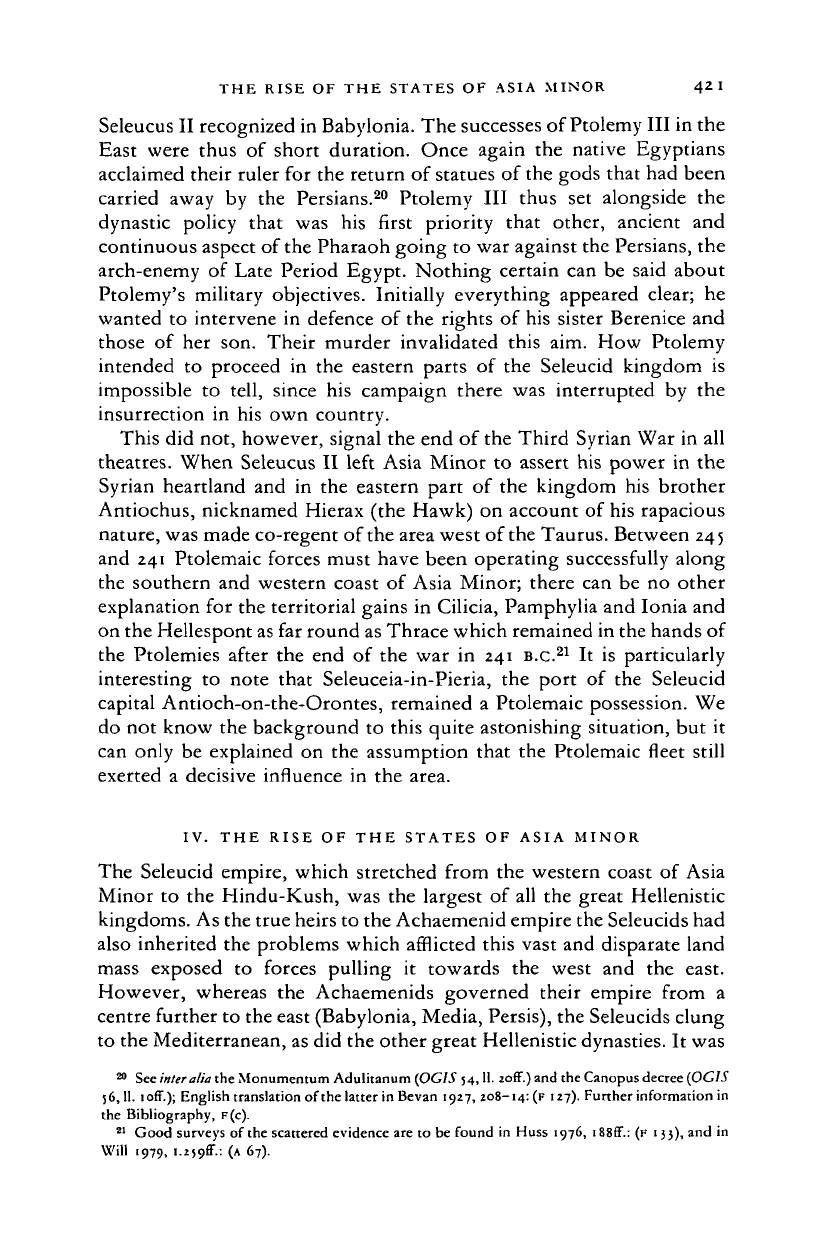
THE RISE OF THE STATES OF ASIA MINOR 4
2 l
Seleucus
II
recognized in Babylonia. The successes of Ptolemy III in the
East were thus
of
short duration. Once again
the
native Egyptians
acclaimed their ruler
for
the return
of
statues
of
the gods that had been
carried away
by the
Persians.
20
Ptolemy
III
thus
set
alongside
the
dynastic policy that
was
his
first priority that other, ancient
and
continuous aspect
of
the Pharaoh going
to
war against the Persians,
the
arch-enemy
of
Late Period Egypt. Nothing certain
can
be
said about
Ptolemy's military objectives. Initially everything appeared clear;
he
wanted
to
intervene
in
defence
of
the rights
of
his sister Berenice
and
those
of
her
son.
Their murder invalidated this
aim.
How
Ptolemy
intended
to
proceed
in
the
eastern parts
of
the
Seleucid kingdom
is
impossible
to
tell, since
his
campaign there
was
interrupted
by
the
insurrection
in
his own
country.
This
did
not, however, signal
the
end
of
the Third Syrian War
in all
theatres. When Seleucus
II
left Asia Minor
to
assert
his
power
in the
Syrian heartland
and
in
the
eastern part
of
the
kingdom
his
brother
Antiochus, nicknamed Hierax (the Hawk)
on
account
of
his rapacious
nature, was made co-regent of
the
area west of
the
Taurus. Between 245
and 241 Ptolemaic forces must have been operating successfully along
the southern
and
western coast
of
Asia Minor; there
can
be no
other
explanation
for
the territorial gains
in
Cilicia, Pamphylia and Ionia and
on the Hellespont as far round as Thrace which remained in the hands of
the Ptolemies after
the end
of
the
war
in
241
B.C.
21
It is
particularly
interesting
to
note that Seleuceia-in-Pieria,
the
port
of
the
Seleucid
capital Antioch-on-the-Orontes, remained
a
Ptolemaic possession.
We
do
not
know
the
background
to
this quite astonishing situation,
but
it
can only
be
explained
on
the
assumption that
the
Ptolemaic fleet still
exerted
a
decisive influence
in
the
area.
IV.
THE
RISE
OF THE
STATES
OF
ASIA MINOR
The Seleucid empire, which stretched from
the
western coast
of
Asia
Minor
to
the
Hindu-Kush,
was the
largest
of
all
the
great Hellenistic
kingdoms. As the true heirs to the Achaemenid empire the Seleucids had
also inherited
the
problems which afflicted this vast and disparate land
mass exposed
to
forces pulling
it
towards
the
west
and
the
east.
However, whereas
the
Achaemenids governed their empire from
a
centre further to the east (Babylonia, Media, Persis), the Seleucids clung
to the Mediterranean, as did the other great Hellenistic dynasties.
It
was
20
See
inter alia
the
Monumentum Adulitanum (OGIS
54,11.
2off.)and
the
Canopus decree
(0G1S
56,11.
ioff.); English translation
of
the latter
in
Bevan
1927,
208-14:
(F
127). Further information
in
the Bibliography,
F(C).
21
Good surveys
of
the
scattered evidence
are
to be
found
in
Huss
1976, 188ff.:
(F 135),
and
in
Will
1979, i.2S9ff.:
(A
67).
Cambridge Histories Online © Cambridge University Press, 2008
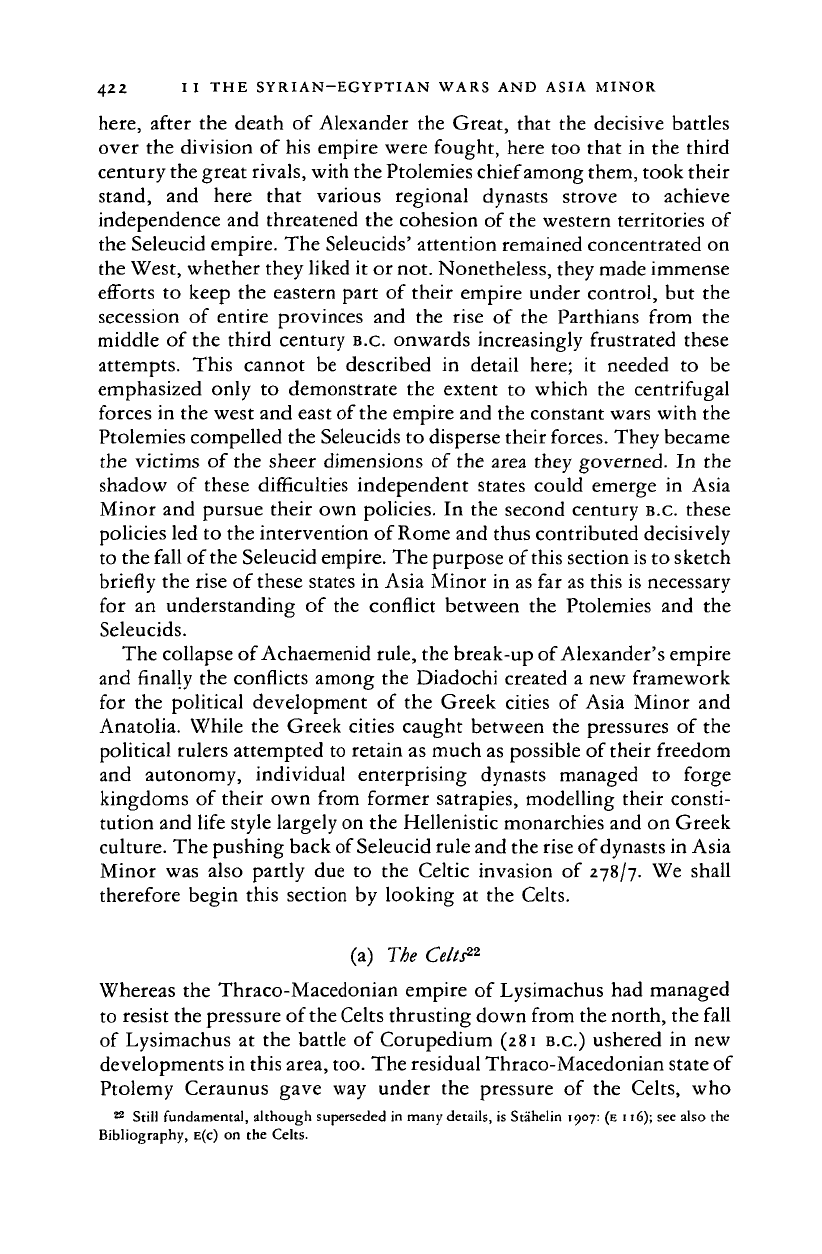
422 II THE SYRIAN-EGYPTIAN WARS AND ASIA MINOR
here,
after
the
death
of
Alexander
the
Great, that
the
decisive battles
over the division
of
his empire were fought, here too that
in
the third
century the great rivals, with the Ptolemies chief among them, took their
stand,
and
here that various regional dynasts strove
to
achieve
independence and threatened the cohesion
of
the western territories
of
the Seleucid empire. The Seleucids' attention remained concentrated on
the West, whether they liked
it
or not. Nonetheless, they made immense
efforts
to
keep the eastern part
of
their empire under control,
but the
secession
of
entire provinces
and the
rise
of
the Parthians from
the
middle
of
the third century
B.C.
onwards increasingly frustrated these
attempts. This cannot
be
described
in
detail here;
it
needed
to be
emphasized only
to
demonstrate
the
extent
to
which
the
centrifugal
forces in the west and east of the empire and the constant wars with the
Ptolemies compelled the Seleucids to disperse their forces. They became
the victims
of
the sheer dimensions
of
the area they governed.
In the
shadow
of
these difficulties independent states could emerge
in
Asia
Minor and pursue their own policies.
In
the second century B.C. these
policies led to the intervention of Rome and thus contributed decisively
to the fall of the Seleucid empire. The purpose of this section is to sketch
briefly the rise
of
these states
in
Asia Minor in as far as this is necessary
for
an
understanding
of
the conflict between
the
Ptolemies
and the
Seleucids.
The collapse of Achaemenid rule, the break-up of Alexander's empire
and finally the conflicts among the Diadochi created a new framework
for
the
political development
of
the Greek cities
of
Asia Minor
and
Anatolia. While
the
Greek cities caught between
the
pressures
of
the
political rulers attempted to retain as much as possible of their freedom
and autonomy, individual enterprising dynasts managed
to
forge
kingdoms
of
their own from former satrapies, modelling their consti-
tution and life style largely on the Hellenistic monarchies and on Greek
culture. The pushing back of Seleucid rule and the rise of dynasts in Asia
Minor
was
also partly
due to the
Celtic invasion
of
278/7.
We
shall
therefore begin this section
by
looking
at the
Celts.
(a) The Celts
22
Whereas
the
Thraco-Macedonian empire
of
Lysimachus had managed
to resist the pressure of the Celts thrusting down from the north, the fall
of Lysimachus
at the
battle
of
Corupedium (281 B.C.) ushered
in
new
developments in this area, too. The residual Thraco-Macedonian state of
Ptolemy Ceraunus gave
way
under
the
pressure
of the
Celts,
who
22
Still fundamental, although superseded
in
many details, is Stahelin 1907:
(E
116); see also the
Bibliography,
E(C)
on the
Celts.
Cambridge Histories Online © Cambridge University Press, 2008
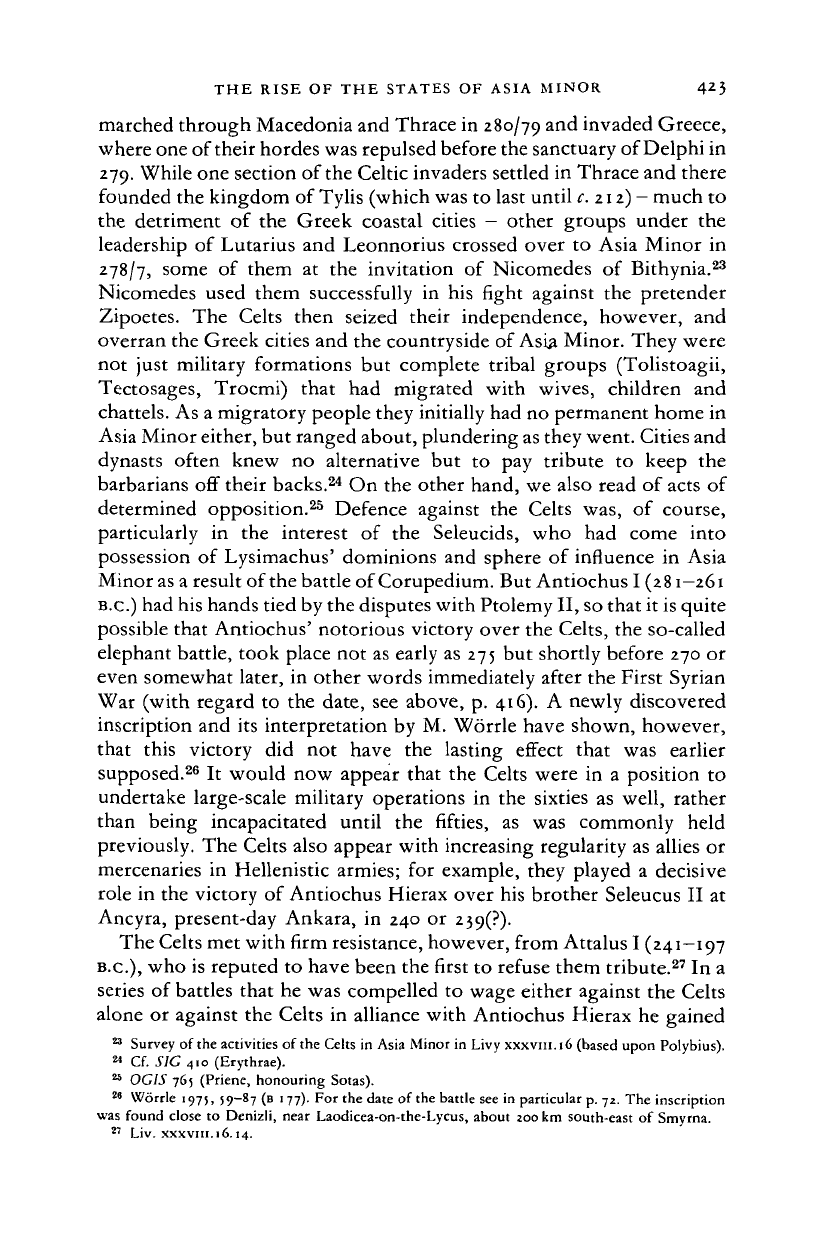
THE RISE OF THE STATES OF ASIA MINOR 4*3
marched through Macedonia and Thrace in 280/79 and invaded Greece,
where one of their hordes was repulsed before the sanctuary of Delphi in
279.
While one section of
the
Celtic invaders settled
in
Thrace and there
founded the kingdom
of
Tylis (which was
to
last until
c.
212)
—
much
to
the detriment
of
the
Greek coastal cities
—
other groups under
the
leadership
of
Lutarius
and
Leonnorius crossed over
to
Asia Minor
in
278/7,
some
of
them
at
the
invitation
of
Nicomedes
of
Bithynia.
23
Nicomedes used them successfully
in
his
fight against
the
pretender
Zipoetes.
The
Celts then seized their independence, however,
and
overran the Greek cities and the countryside
of
Asia Minor. They were
not just military formations
but
complete tribal groups (Tolistoagii,
Tectosages, Trocmi) that
had
migrated with wives, children
and
chattels. As a migratory people they initially had no permanent home
in
Asia Minor either, but ranged about, plundering as they went. Cities and
dynasts often knew
no
alternative
but to
pay
tribute
to
keep
the
barbarians
off
their backs.
24
On
the other hand, we also read
of
acts
of
determined opposition.
25
Defence against
the
Celts
was,
of
course,
particularly
in the
interest
of
the
Seleucids,
who
had
come into
possession
of
Lysimachus' dominions
and
sphere
of
influence
in
Asia
Minor as a result of the battle of Corupedium. But Antiochus 1(281—261
B.C.) had his hands tied by the disputes with Ptolemy II, so that
it
is quite
possible that Antiochus' notorious victory over the Celts, the so-called
elephant battle, took place
not
as early as 275 but shortly before 270
or
even somewhat later,
in
other words immediately after the First Syrian
War (with regard
to the
date,
see
above,
p.
416).
A
newly discovered
inscription and
its
interpretation
by
M. Worrle have shown, however,
that this victory
did not
have
the
lasting effect that
was
earlier
supposed.
26
It
would
now
appear that
the
Celts were
in
a
position
to
undertake large-scale military operations
in the
sixties
as
well, rather
than being incapacitated until
the
fifties,
as
was
commonly held
previously. The Celts also appear with increasing regularity as allies
or
mercenaries
in
Hellenistic armies;
for
example, they played
a
decisive
role
in
the victory
of
Antiochus Hierax over his brother Seleucus
II at
Ancyra, present-day Ankara,
in
240
or
2
39(?).
The Celts met with firm resistance, however, from Attalus
I
(241—197
B.C),
who is reputed
to
have been the first
to
refuse them tribute.
27
In
a
series
of
battles that
he
was compelled
to
wage either against
the
Celts
alone
or
against
the
Celts
in
alliance with Antiochus Hierax
he
gained
23
Survey
of
the
activities
of
the
Celts
in
Asia Minor
in
Livy xxxvm.16 (based upon Polybius).
24
Cf.
SIG
410
(Erythrae).
25
0C1S
765 (Priene, honouring Sotas).
26
Worrle
1975,
59-87 (B
177). For the
date
of
the
battle
see
in
particular
p. 72. The
inscription
was found close
to
Denizli, near Laodicea-on-the-Lycus, about
zoo km
south-east
of
Smyrna.
27
Liv.
XXXVIII.
16.14.
Cambridge Histories Online © Cambridge University Press, 2008

424 I I THE SYRIAN-EGYPTIAN WARS AND ASIA MINOR
mastery over them
and
at
the
same time greatly extended
his own
sovereignty.
28
These battles have an importance that reaches beyond the
purely military
and
political sphere, since they prompted
the
famous
representations of the victories over the Celts and thus led to the birth of
Pergamene art.
In the
sacred enclosure
of
the Pergamene city goddess
Athena Attalus had works
of
sculpture erected which were intended
to
portray Pergamum as a centre of Hellenistic culture and Attalus himself
as
its
champion against
the
barbarians.
29
In
the
centre
of
the
grand
square before
the
temple
of
Athena stood
a
round plinth, which
probably supported
not
a group
of
Galatians
but
the statue
of
Athena.
The sculptures
of
the Galatians stood
on
two long bases bordering
the
sacred way
to the
temple. The bronze originals
of
these sculptures
are
lost;
all
that remains
are
marble copies dating from
the
time
of
the
Roman empire. The attribution of individual sculptures
to
the Galatian
monument
of
Attalus
I is
arguable
in
many cases,
but the
famous
representation
of
the Dying Gaul
and the
Gaul killing himself and
his
wife certainly formed part
of it.
There
is
also debate about
the
positioning
of
the individual figures and the part played by the sculptor
Epigonus
in
the
overall conception
of
the monument.
The
Celts
and
their opponents
are
depicted
as
individuals
and
not
woven into
a
mythological setting, as was later the case on the 'Pergamum altar'. The
appearance
of
these statues gives some idea
of
the effect that
the
wild
barbarians from
the
north must have
had
on
their contemporaries.
Despite the fact that their subject conforms to the tradition of portraying
barbarians, the sculptors working for Attalus succeeded in depicting the
full
awe
of
the suffering
and
death
of
the defeated Celts.
30
The confinement of the Celts to
a
permanent place of settlement in the
north
of
Greater Phrygia (subsequently called Galatia) was obviously a
very long process in which their defeat at the hands of Antiochus
I
in the
elephant battle probably did not play as decisive a role as has frequently
been assumed hitherto. Archaeological evidence
for
the presence
of
the
Celts
in
the
third century B.C.
has
been found mainly
in
the
western
coastal area of Asia Minor; not until the second century is there
a
body of
material from central Anatolia.
31
The
settlement
of
the Celts
in
these
partly desolate areas was certainly not entirely voluntary; the successful
28
Important
in
this regard above all
the
evidence
of
inscriptions: OGIS
zdgff.
29
See the
recent work
by
Kiinzl
(1971:
(E
110))
and
Wenning (1978:
(E
117); pi. 20
gives
a
reconstructed plan of the enclosure of Athena with the Galatian monument of Attalus
I).
Regarding
the accentuation
of
the barbarian theme
in
the Galatian wars
of
Attalus I see Cardinali 1906, 23-39:
(E
120).
See
Plates vol.,
pis.
59-60.
30
R. Ozgan.'BermerkungenzumgroBenGallieranathem',
A A
1981,489-510, offers new views
about
the
positioning and interpretation
of
this group.
In
his opinion, marble,
not
bronze, would
have been
the
material
of
the original.
31
Polenz 1978, 181-220: (E 115). The fact that there
is
so little archaeological evidence
for the
presence
of
the Celts
in
central Anatolia
in the
third century
is,
however, surprising.
Cambridge Histories Online © Cambridge University Press, 2008
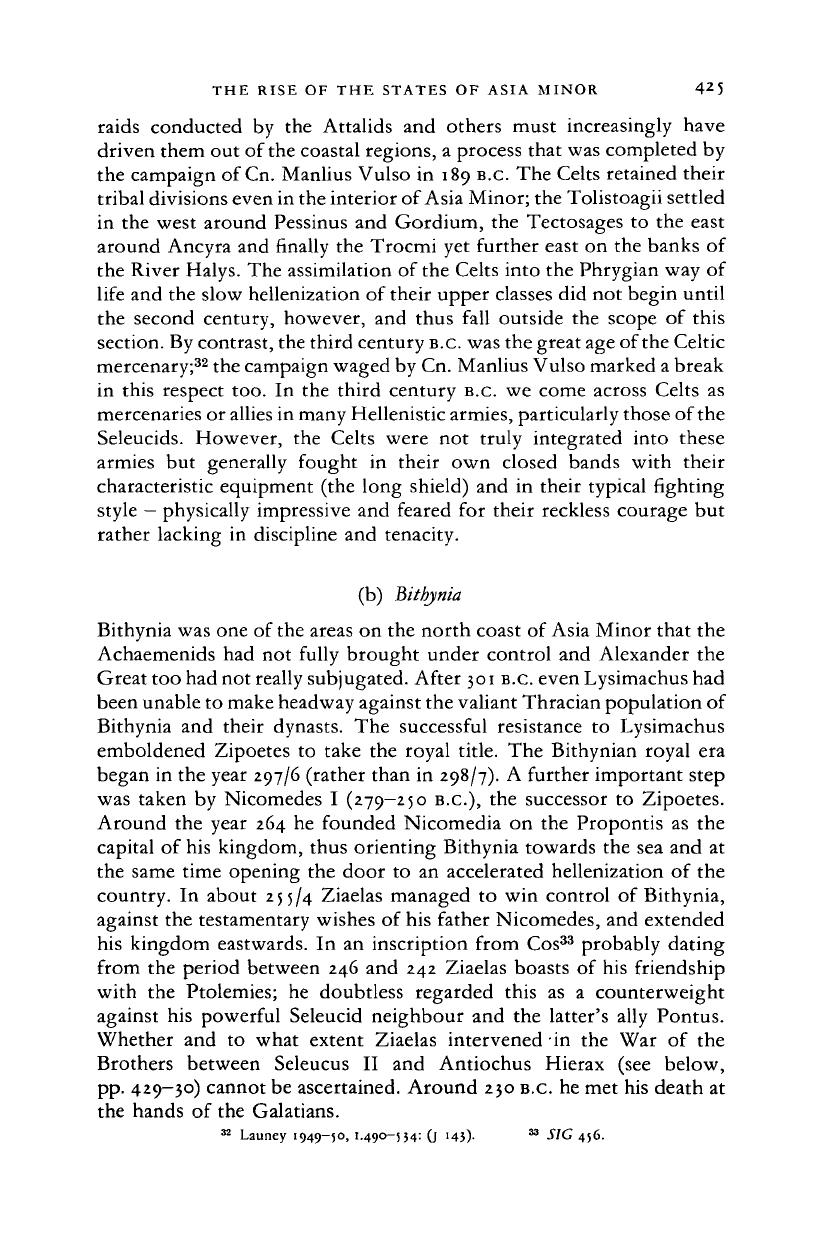
THE RISE OF THE STATES OF ASIA MINOR 4
2
5
raids conducted
by the
Attalids
and
others must increasingly have
driven them out of the coastal regions,
a
process that was completed
by
the campaign
of
Cn.
Manlius Vulso
in
189 B.C. The Celts retained their
tribal divisions even in the interior of Asia Minor; the Tolistoagii settled
in
the
west around Pessinus
and
Gordium,
the
Tectosages
to the
east
around Ancyra and finally
the
Trocmi
yet
further east
on
the banks
of
the River Halys. The assimilation
of
the Celts into the Phrygian way
of
life and the slow hellenization
of
their upper classes did not begin until
the second century, however,
and
thus fall outside
the
scope
of
this
section. By contrast, the third century
B.C.
was the great age of the Celtic
mercenary;
32
the campaign waged by Cn. Manlius Vulso marked a break
in this respect too.
In the
third century B.C.
we
come across Celts
as
mercenaries or allies in many Hellenistic armies, particularly those of the
Seleucids. However,
the
Celts were
not
truly integrated into these
armies
but
generally fought
in
their
own
closed bands with their
characteristic equipment (the long shield)
and in
their typical fighting
style
-
physically impressive
and
feared
for
their reckless courage
but
rather lacking
in
discipline
and
tenacity.
(b) Bithynia
Bithynia was one
of
the areas
on
the north coast
of
Asia Minor that
the
Achaemenids
had not
fully brought under control
and
Alexander
the
Great too had not really subjugated. After
301
B.C.
even Lysimachus had
been unable to make headway against the valiant Thracian population of
Bithynia
and
their dynasts.
The
successful resistance
to
Lysimachus
emboldened Zipoetes
to
take
the
royal title.
The
Bithynian royal
era
began
in
the year 297/6 (rather than
in
298/7).
A
further important step
was taken
by
Nicomedes
I
(279—250 B.C.),
the
successor
to
Zipoetes.
Around
the
year 264
he
founded Nicomedia
on the
Propontis
as the
capital
of
his kingdom, thus orienting Bithynia towards
the sea and at
the same time opening
the
door
to an
accelerated hellenization
of the
country.
In
about 255/4 Ziaelas managed
to win
control
of
Bithynia,
against the testamentary wishes
of
his father Nicomedes,
and
extended
his kingdom eastwards.
In an
inscription from Cos
33
probably dating
from
the
period between 246
and
242 Ziaelas boasts
of
his friendship
with
the
Ptolemies;
he
doubtless regarded this
as a
counterweight
against
his
powerful Seleucid neighbour
and the
latter's ally Pontus.
Whether
and to
what extent Ziaelas intervened
in the War of the
Brothers between Seleucus
II and
Antiochus Hierax
(see
below,
pp.
429-30) cannot be ascertained. Around 230
B.C.
he met his death
at
the hands
of
the Galatians.
32
Launey 1949-jO, 1.490-534:
(j 143).
**
SIC
456.
Cambridge Histories Online © Cambridge University Press, 2008
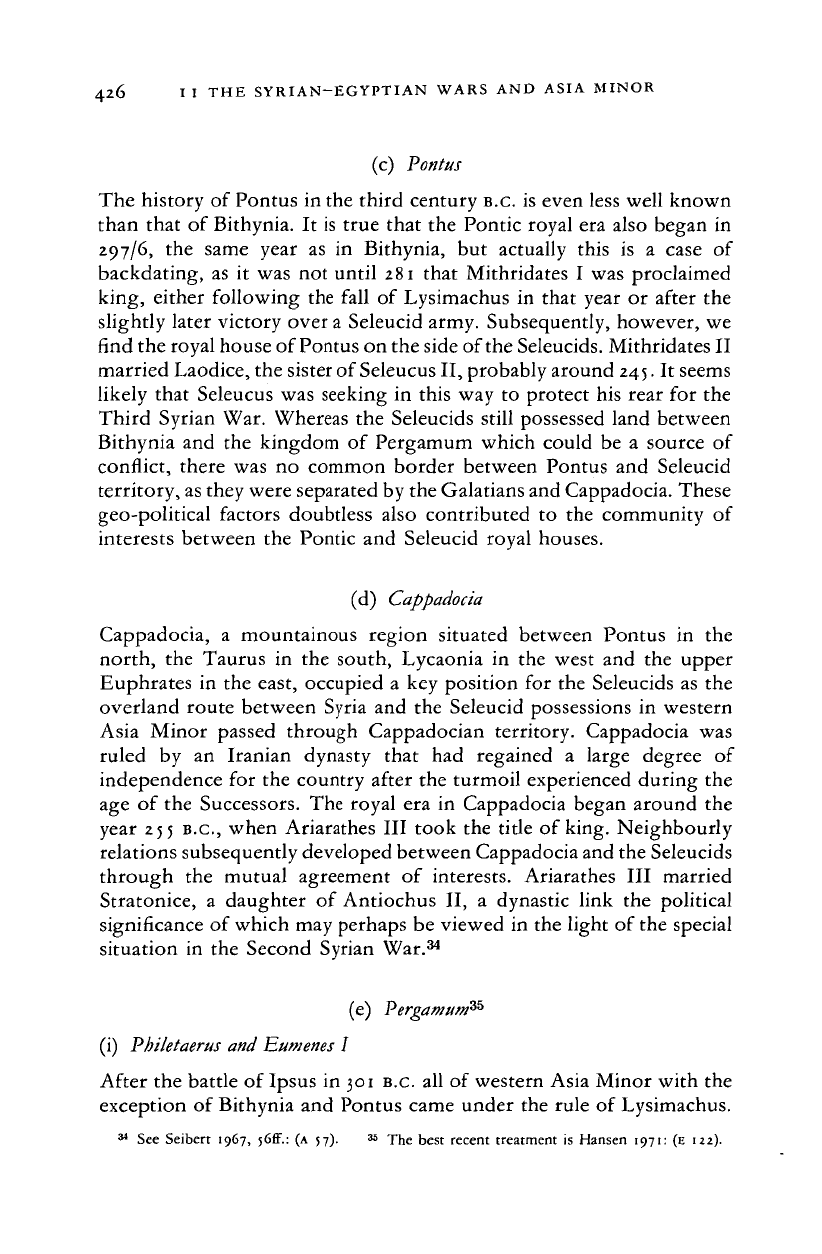
426 I I THE SYRIAN-EGYPTIAN WARS AND ASIA MINOR
(c) Pontus
The history
of
Pontus
in the
third century
B.C.
is
even less well known
than that
of
Bithynia.
It is
true that
the
Pontic royal
era
also began
in
297/6,
the
same year
as in
Bithynia,
but
actually this
is a
case
of
backdating,
as it was not
until
281
that Mithridates
I was
proclaimed
king,
either following
the
fall
of
Lysimachus
in
that year
or
after
the
slightly later victory over
a
Seleucid army. Subsequently, however,
we
find the royal house
of
Pontus
on the
side of the Seleucids. Mithridates
II
married Laodice,
the
sister
of
Seleucus
II,
probably around 245.
It
seems
likely that Seleucus
was
seeking
in
this
way to
protect
his
rear
for the
Third Syrian
War.
Whereas
the
Seleucids still possessed land between
Bithynia
and the
kingdom
of
Pergamum which could
be a
source
of
conflict, there
was no
common border between Pontus
and
Seleucid
territory, as they were separated
by the
Galatians
and
Cappadocia. These
geo-political factors doubtless also contributed
to the
community
of
interests between
the
Pontic
and
Seleucid royal houses.
(d)
Cappadocia
Cappadocia,
a
mountainous region situated between Pontus
in the
north,
the
Taurus
in the
south, Lycaonia
in the
west
and the
upper
Euphrates
in the
east, occupied
a key
position
for the
Seleucids
as the
overland route between Syria
and the
Seleucid possessions
in
western
Asia Minor passed through Cappadocian territory. Cappadocia
was
ruled
by an
Iranian dynasty that
had
regained
a
large degree
of
independence
for the
country after
the
turmoil experienced during
the
age
of the
Successors.
The
royal
era in
Cappadocia began around
the
year
255 B.C.,
when Ariarathes
III
took
the
title
of
king. Neighbourly
relations subsequently developed between Cappadocia
and the
Seleucids
through
the
mutual agreement
of
interests. Ariarathes
III
married
Stratonice,
a
daughter
of
Antiochus
II, a
dynastic link
the
political
significance
of
which
may
perhaps
be
viewed
in the
light
of the
special
situation
in the
Second Syrian War.
34
(e)
Pergamum
35
(i) Philetaerus and Eumenes
I
After
the
battle
of
Ipsus
in
301
B.C.
all of
western Asia Minor with
the
exception
of
Bithynia
and
Pontus came under
the
rule
of
Lysimachus.
34
See
Seibert
1967, s6ff.:
(A
57). 35
The
best recent treatment
is
Hansen 1971: (E
122).
Cambridge Histories Online © Cambridge University Press, 2008
